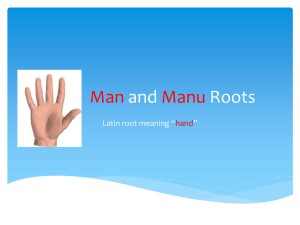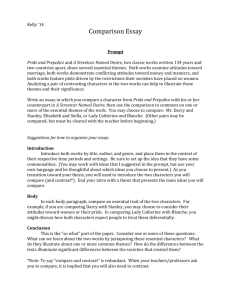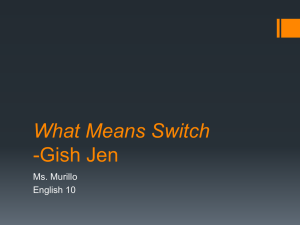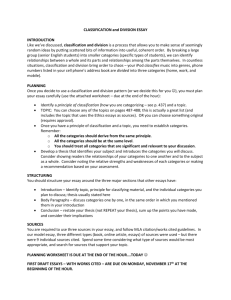DOCX
advertisement
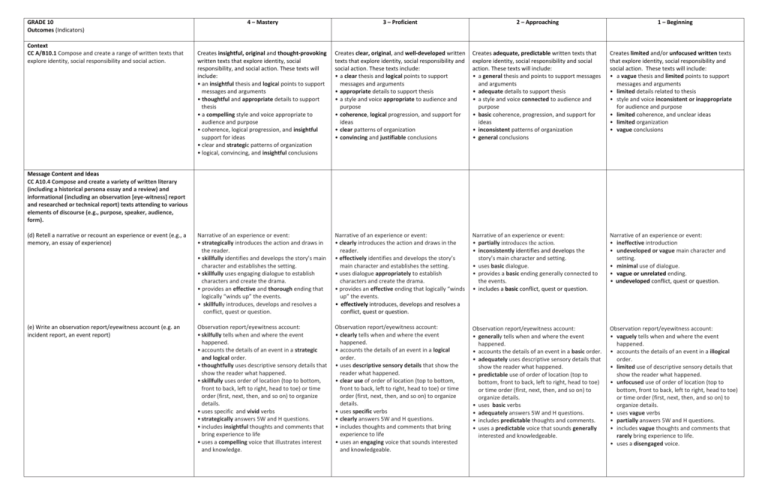
GRADE 10 Outcomes (Indicators) 4 – Mastery 3 – Proficient 2 – Approaching Creates insightful, original and thought-provoking written texts that explore identity, social responsibility, and social action. These texts will include: • an insightful thesis and logical points to support messages and arguments • thoughtful and appropriate details to support thesis • a compelling style and voice appropriate to audience and purpose • coherence, logical progression, and insightful support for ideas • clear and strategic patterns of organization • logical, convincing, and insightful conclusions Creates clear, original, and well-developed written texts that explore identity, social responsibility and social action. These texts include: • a clear thesis and logical points to support messages and arguments • appropriate details to support thesis • a style and voice appropriate to audience and purpose • coherence, logical progression, and support for ideas • clear patterns of organization • convincing and justifiable conclusions Creates adequate, predictable written texts that explore identity, social responsibility and social action. These texts will include: • a general thesis and points to support messages and arguments • adequate details to support thesis • a style and voice connected to audience and purpose • basic coherence, progression, and support for ideas • inconsistent patterns of organization • general conclusions Creates limited and/or unfocused written texts that explore identity, social responsibility and social action. These texts will include: • a vague thesis and limited points to support messages and arguments • limited details related to thesis • style and voice inconsistent or inappropriate for audience and purpose • limited coherence, and unclear ideas • limited organization • vague conclusions (d) Retell a narrative or recount an experience or event (e.g., a memory, an essay of experience) Narrative of an experience or event: • strategically introduces the action and draws in the reader. • skillfully identifies and develops the story’s main character and establishes the setting. • skillfully uses engaging dialogue to establish characters and create the drama. • provides an effective and thorough ending that logically “winds up” the events. • skillfully introduces, develops and resolves a conflict, quest or question. Narrative of an experience or event: • clearly introduces the action and draws in the reader. • effectively identifies and develops the story’s main character and establishes the setting. • uses dialogue appropriately to establish characters and create the drama. • provides an effective ending that logically “winds up” the events. • effectively introduces, develops and resolves a conflict, quest or question. Narrative of an experience or event: • partially introduces the action. • inconsistently identifies and develops the story’s main character and setting. • uses basic dialogue. • provides a basic ending generally connected to the events. • includes a basic conflict, quest or question. Narrative of an experience or event: • ineffective introduction • undeveloped or vague main character and setting. • minimal use of dialogue. • vague or unrelated ending. • undeveloped conflict, quest or question. (e) Write an observation report/eyewitness account (e.g. an incident report, an event report) Observation report/eyewitness account: • skilfully tells when and where the event happened. • accounts the details of an event in a strategic and logical order. • thoughtfully uses descriptive sensory details that show the reader what happened. • skillfully uses order of location (top to bottom, front to back, left to right, head to toe) or time order (first, next, then, and so on) to organize details. • uses specific and vivid verbs • strategically answers 5W and H questions. • includes insightful thoughts and comments that bring experience to life • uses a compelling voice that illustrates interest and knowledge. Observation report/eyewitness account: • clearly tells when and where the event happened. • accounts the details of an event in a logical order. • uses descriptive sensory details that show the reader what happened. • clear use of order of location (top to bottom, front to back, left to right, head to toe) or time order (first, next, then, and so on) to organize details. • uses specific verbs • clearly answers 5W and H questions. • includes thoughts and comments that bring experience to life • uses an engaging voice that sounds interested and knowledgeable. Observation report/eyewitness account: • generally tells when and where the event happened. • accounts the details of an event in a basic order. • adequately uses descriptive sensory details that show the reader what happened. • predictable use of order of location (top to bottom, front to back, left to right, head to toe) or time order (first, next, then, and so on) to organize details. • uses basic verbs • adequately answers 5W and H questions. • includes predictable thoughts and comments. • uses a predictable voice that sounds generally interested and knowledgeable. Observation report/eyewitness account: • vaguely tells when and where the event happened. • accounts the details of an event in a illogical order. • limited use of descriptive sensory details that show the reader what happened. • unfocused use of order of location (top to bottom, front to back, left to right, head to toe) or time order (first, next, then, and so on) to organize details. • uses vague verbs • partially answers 5W and H questions. • includes vague thoughts and comments that rarely bring experience to life. • uses a disengaged voice. Context CC A/B10.1 Compose and create a range of written texts that explore identity, social responsibility and social action. 1 – Beginning Message Content and Ideas CC A10.4 Compose and create a variety of written literary (including a historical persona essay and a review) and informational (including an observation [eye-witness] report and researched or technical report) texts attending to various elements of discourse (e.g., purpose, speaker, audience, form). (f) Write an inquiry report (e.g.. research report, an I-Search, a technical report. Inquiry report: • presents an insightful introduction relevant to inquiry questions. • puts central ideas into a well-defined focus or thesis statement relevant to inquiry questions. • Strategically includes information related to focus or thesis, is current, and drawn from reliable, relevant sources that are cited. • includes a body that strategically develops the details of the subject. • Skillfully provides a compelling conclusion and final statement that fully address inquiry questions. Inquiry report: • presents an interesting introduction relevant to inquiry questions. • puts central ideas into a focus or thesis statement relevant to inquiry questions. • includes information related to focus or thesis, is current, and drawn from reliable, relevant sources that are cited. • includes a body that logically develops the details of the subject. • provides a clear conclusion with a final statement that answers inquiry questions. g) Write a historical persona essay (e.g., biographical narrative, response to a historical photo) Historical persona essay: • includes a historic person. • strategically defines important moments in the historic person’s life so essay is insightful. • demonstrates perceptive understanding of the person, the events, and gathered details about the place and time. • includes insightful reflections and observations about person’s life and experiences. • creates, insightful, accurate and comprehensive depictions of the probable contemporaries of the historic person. • skillfully uses dialogue to bring characters to life. • employs a skillfull organization. (h) Write a review (e.g., evaluating a literary work) Review: • includes well-developed, insightful explanations and comprehensive references to the text itself. • thoughtfully expresses opinions about the value or worth of the subject in order to help audience decide. • skillfully explores strengths and weaknesses of work and includes significant passages from text as examples. • thoughtfully justifies opinion. • insightfully addresses what makes the text interesting, exciting, engaging, believable, unforgettable, and significant. • skillfully recognizes theme of the text and the relevance of literary techniques. ( Inquiry report: • presents a basic introduction to inquiry questions. • puts central ideas into a general focus or thesis statement that adequately addresses inquiry questions. • inconsistently includes information related to focus or thesis, is current, and drawn from reliable, relevant sources that are cited. • includes a body that adequately develops the details of the subject. • provides a basic conclusion with a final statement that generally addresses inquiry questions . Inquiry report: • presents a limited introduction to inquiry questions. • puts ideas into a vague focus or thesis statement. • rarely includes information related to focus or thesis, is current, and drawn from reliable, relevant sources that are cited. • includes a body that illogically develops l the details of the subject. • Provides a vague conclusion with a final statement that vaguely addresses inquiry questions. Historical persona essay: • includes a historic person. • clearly defines important moments in the historic person’s life so essay is well-focused. • shows clear understanding of the person, the events, and gathered details about the place and time. • includes reflections and observations about person’s life and experiences. • creates accurate depictions of the probable contemporaries of the historic person. • uses appropriate dialogue to bring characters to life. • employs an easy-to-follow organization. Historical persona essay: • includes a historic person. • includes basic information from the historic person’s life. • shows basic understanding of the person, the events, and the place and time. • includes basic observations about person’s life and experiences. • creates basic depictions of the probable contemporaries of the historic person. • uses basic dialogue. • inconsistent organization. Historical persona essay: • includes a historic person. • inaccurate or inadequate information of the historic person’s life. • shows limited or inaccurate understanding of the person, the events, and place and time. • includes vague or unrelated observations about person’s life and experiences. • lists probable contemporaries of the historic person. • minimal use of dialogue. • limited organization. Review: • includes thoughtful explanations and specific references to the text itself. • clearly expresses opinions about the value or worth of the subject in order to help audience decide. • clearly explores strengths and weaknesses of work and includes passages from text as examples. • justifies opinion. • clearly addresses what makes the text interesting, exciting, engaging, believable, unforgettable, and significant. • recognizes theme of the text and the relevance of literary techniques. Review: • includes adequate explanations and references to the text itself. • adequately expresses opinions about the value or worth of the subject in order to help audience decide. • adequately explores strengths and weaknesses of work and includes passages from text as examples. • generally justifies opinion. • adequately addresses what makes the text interesting, exciting, engaging, believable, unforgettable, and significant. • adequately recognizes theme of the text and the relevance of literary techniques. CC B10.4 Create a variety of written informational (including a business letter, biographical profile, problem-solution essay) and literary (including fictionalized journal entries and a short script) communications. (d) Write an explanation and defence of personal point of view Review: • includes limited explanations and vague references to the text itself. • expresses vague opinions about the value or worth of the subject in order to help audience decide. • partially explores strengths and weaknesses of work and includes limited passages from text as examples. • partially justifies opinion. • partially addresses what makes the text interesting, exciting, engaging, believable, unforgettable, and significant. • partially recognizes theme of the text and the relevance of literary techniques. . Explanation and defence: • explains with precise and expansive details writer’s beliefs about an important subject • skillfully identifies focus in opening paragraph • organizes ideas in a skillfull, original sequence • includes effective transitions • provides complex and convincing conclusions. Explanation and defence: • explains with appropriate details writer’s beliefs about an important subject • clearly identifies focus of essay in opening paragraph • organizes ideas in a logical and appropriate sequence • includes smooth transitions • provides logical and convincing conclusions. Explanation and defence: • explains with general details writer’s beliefs about an important subject • generally identifies focus of essay in opening paragraph • organizes ideas in a sequence • includes some transitions • provides basic conclusions Explanation and defence: • explains with insufficient details writer’s beliefs about a subject • partially identifies focus of essay in opening paragraph • organizes ideas in an illogical and inappropriate sequence • includes ineffective transitions • provides insufficient conclusions. (e) Write a biographical profile (f) Write a problem-solution essay (e.g. an essay in which you analyze a problem and present one or more solutions (g) Write a business letter (e.g., letter of complaint, email request) (h) Write fictionalized journal entries (e.gl, of a literary character or a historical figure) (i) Write a short script (e.g., a short play or a script for an advertisement) Biographical profile: • includes comprehensive ideas learned about the person • begins by sharing important, signficiant background information • thoughtfully describes the subject and explains what he or she accomplished • creative ending leaves the readers with something to think about and consider. Biographical profile: • includes key ideas learned about the person • begins by clearly sharing important background information • clearly describes the subject and explains what he or she accomplished • ends by leaving the readers with something to think about and consider. Biographical profile: • includes some key ideas learned about the person • begins by sharing basic background information • adequately describes the subject and explains some of what he or she accomplished • some evidence of leaving the readers with something to think about and consider. Problem-solution essay: • focuses on a significant problem that is important to self • identifies the problem in an insightful statement • comprehensively analyzes all aspects of the problem, explaining its parts, history, and causes • critically weighs a wide variety of possible solutions • skilfully explains why situation exists and how it can be fixed • includes compelling facts and reasons • ends with a skillful explanation of what the writer would like to see done. Problem-solution essay: • focuses on a problem that is important to self • identifies the problem in a clear statement • thoroughly analyzes the problem, explaining its parts, history, and causes • accurately weighs possible solutions • clearly explains why situation exists and how it can be fixed • includes all the important facts and reasons • ends effectively explaining what the writer would like to see done. Problem-solution essay: • adequately focuses on a problem that is important to self • identifies the problem in a basic statement • provides some analysis of the problem, explaining some parts, history, and causes • adequately weighs possible solutions • offers some explanation of why the situation exists and how it can be fixed • includes some facts and reasons • ends with a simple explanation of what the writer would like to see done. Business letter: • accurately uses a consistent style (semi-block or full block) • presents information strategically and in the correct order • includes all the parts of a business letter – heading, inside address, salutation, body, complimentary closing, and signature • skillfully states purpose • provides comprehensive and compelling details • skillfully states intent Business letter: • uses a consistent style (semi-block or full block) • presents information completely and in the correct order • includes all the parts of a business letter – heading, inside address, salutation, body, complimentary closing, and signature • clearly, immediately states purpose • provides accurate and complete details • clearly states intent Business letter: • uses an inconsistent style (semi-block or full block) • presents basic information and in the correct order • includes some parts of a business letter – heading, inside address, salutation, body, complimentary closing, and signature • states basic purpose • provides basic and adequate details • states intent Fictionalized journal entry: • insightful focus on a character • insightful focus on an ongoing event or experience • contain insightful impressions, reflections, and observations about life, people, and experiences • skillfully provides insight into the personality and values of the character. Fictionalized journal entry: • clear focus on a character • clear focus on an ongoing event or experience • contain impressions, reflections, and observations about life, people, and experiences • provides relevant insight into the personality and values of the character. Fictionalized journal entry: • inconsistent focus on character • inconsistent focus on an ongoing event or experience • contain adequate impressions, reflections, and observations about life, people, and experiences • provides basic description of the personality and values of the character. Short Script: • comprehensive stage directions: time, place, characters and actions, entrances, and exits. • gives comprehensive details of setting that lead into the beginning of the script • employs sophisticated dialogue that moves the action along • skillfully builds around a creative conflict or problem • skillfully includes (if multimedia) graphics, music, Blend In, Cut To, Fade In, Fade Out, Insert, and other elements. Short Script: • clear stage directions: time, place, characters, action, entrances and exits. • gives clear details of setting that lead into the beginning of the script • employs dialogue that moves the action along • builds around a believable conflict or problem that makes sense in the lives of the main characters • includes (if multimedia) graphics, music, Blend In, Cut To, Fade In, Fade Out, Insert, and other elements. Short Script: • includes basic stage directions: some information on time, characters, actions, entrances and/or exits. • gives basic details of setting that lead into the beginning of the script • employs basic dialogue • builds around a simple conflict or problem • includes basic (if multimedia) graphics, music, Blend In, Cut To, Fade In, Fade Out, Insert, and other elements. Biographical profile: • includes limited ideas learned about the person • begins by sharing limited background information • vaguely describes the subject and partially explains what he or she accomplished • does not leave the readers with something to think about and consider. Problem-solution essay: • lacks focus on a problem of importance • identifies the problem in a vague statement • limited analysis of the problem • limited discussion of solutions • vague explanation of why situation exists and how it can be fixed • limited facts and reasons • ends with a limited explanation of what the writer would like to see done. Business letter: • uses an inconsistent style (semi-block or full block) • presents insufficient information and/or an illogical order. • includes some parts of a business letter – heading, inside address, salutation, body, complimentary closing, and signature • inadequately states purpose • provides insufficient and/or inaccurate details • ineffectively states intent Fictionalized journal entry: • unfocused attention on character • unfocused attention on an ongoing event or experience • contain limited impressions, reflections, and observations about life, people, and experiences • provides limited description of the personality and values of the character. Short Script: • includes limited stage directions: time, place, characters, actions, entrances and/or exits. • gives limited or no details of setting that lead into the beginning of the script • employs ineffective dialogue. • Conflict or problem is not believable or doesn’t makes sense in the lives of the main characters • includes limited (if multimedia) graphics, music, Blend In, Cut To, Fade In, Fade Out, Insert, and other elements. Use of Strategies CC A/B10.4 b. Select, use, and evaluate purposefully a variety of before, during, and after strategies to construct and communicate meaning when writing. BEFORE • Skillfully generates prompts or a topic and activates prior knowledge. • Thoughtfully considers purpose and audience. • Generates and identifies comprehensive ideas and information. • Strategically chooses/adapts a possible form. • Skillfully collects and focuses relevant and compelling ideas and information. • Strategically plans and organizes ideas for drafting. BEFORE • Considers prompts or finds a topic and activates prior knowledge. • Considers purpose and audience. • Considers and generates specific ideas and information. • Considers and purposefully chooses/adapts a possible form. • Collects and focuses ideas and information. • Plans and organizes ideas for drafting. BEFORE • Generally considers or finds a topic and activates prior knowledge. • Generally considers purpose and audience. • Generally considers and generates ideas and information. • Generally considers or chooses a possible form. • Collects general ideas and information. • Some planning and organizing of ideas for drafting. BEFORE • Rarely considers prompts or finds a topic and activates prior knowledge. • Rarely considers purpose and audience. • Rarely considers ideas and information. • Rarely considers form. • Rarely collects ideas and information. • Little evidence of planning and organizing ideas for drafting. DURING • Creates draft(s) and confidently experiments with possible product(s) DURING • Creates draft(s) and experiments with possible product(s). DURING • Creates some draft(s) and may experiment with possible product(s) DURING • Partially creates draft(s) and ineffectively experiments with possible product(s) • Skillfully uses language and its cues and conventions to compose and create a message. • Competently uses language and its cues and conventions to compose and create a message. • Inconsistent use of language and its cues and conventions to compose and create a message • Strategically confers with others to create quality text. • Purposefully confers with others to create quality text. • Inconsistently confers with others to improve text. • Uses language and its cues and conventions inaccurately or ineffectively to compose and create a message. • Skillfully reflects, clarifies, self-monitors, selfcorrects, and uses a variety of “fix-up” strategies. • Confidently experiments with communication features and techniques (content, organization, purpose, audience, context). • Clearly reflects, clarifies, self-monitors, selfcorrects, and uses a variety of “fix-up” strategies. • Competently experiments with communication features and technique. • Inconsistent use of “fix-up” strategies • Basic use of communication features and techniques. • Limited or inaccurate use of “fix-up” strategies. • Limited or inaccurate use of communication features and techniques. AFTER • Consistently revises for content, meaning and organization by adding, deleting, substituting, and rethinking. • Skilfully revises for sentence structure, word choice, spelling, and mechanics. AFTER • Revises for content, meaning and organization by adding, deleting, substituting, and rethinking. • Accurately revises for sentence structure, word choice, spelling, and mechanics. AFTER • lnconsistent revision of content, meaning and organization. • Inconsistent revision of sentence structure, word choice, spelling, and mechanics. AFTER • Limited revision of content, meaning and organization. • Limited or incorrect revision of sentence structure, word choice, spelling, and mechanics. • Purposefully confers with peers, teacher, or others to create quality text. • Inconsistently confers with peers, teacher, or others to improve text. • Rarely confers with peers, teacher, or others to improve text. PRAGMATIC • Strategically selects and uses language register appropriate for the subject, context, audience, and purpose. • Consistently uses conventional “standard” English when required. PRAGMATIC • Purposefully selects and uses language register appropriate for the subject, context, audience, and purpose. • Uses conventional “standard” English when required. PRAGMATIC • Inconsistent use of language connected to subject, context, audience, and purpose. • Inconsistent use of conventional “standard” English when required. PRAGMATIC • Limited or incorrect use of language register for the subject, context, audience, and purpose. • Limited use of conventional “standard” English when required. TEXTUAL TEXTUAL TEXTUAL TEXTUAL • Strategically confers with peers, teacher, or others to create quality text. Cues and Conventions CC A/B10.4 c. Understand and apply the pragmatic, textual, syntactic, semantic/lexical/morphological, graphophonic and other language cues and conventions to construct and communicate meaning when writing. • Limited evidence of conferring with others. • Strategically selects and uses modes of discourse (descriptive, narrative, expository, or persuasive) and text forms appropriate for subject, purpose, and audience. • Skilfully creates texts that are unified and compelling. • Purposefully selects and uses modes of discourse (descriptive, narrative, expository, or persuasive) and text forms appropriate for subject, purpose, and audience. • Competently creates texts that are unified and coherent. • Inconsistent use of modes of discourse (descriptive, narrative, expository, or persuasive) and text forms for subject, purpose, and audience. • Creates basic texts with adequate evidence of coherence. • Limited or incorrect use of modes of discourse (descriptive, narrative, expository, or persuasive) and text forms. • Creates texts that lack unity and coherence. SYNTACTICAL • Skillfully selects and uses formal written sentences that are compelling, meaningful, correctly punctuated, and devoid of ambiguous expressions. • Skillfully uses sentences that are varied in form (including subordination and parallelism). • Skillfully demonstrates control over such elements as subject-verb agreement, pronounantecedent agreement, pronoun reference, pronoun agreement, verb forms, verb tense, correct use of that/which, who/whom. SYNTACTICAL • Competently selects and uses formal written sentences that are meaningful, clear, correctly punctuated, and devoid of ambiguous expressions. • Consistently uses sentences that are varied in form (including subordination and parallelism). • Consistently demonstrates control over such elements as subject-verb agreement, pronounantecedent agreement, pronoun reference, pronoun agreement, verb forms, verb tense, correct use of that/which, who/whom. SYNTACTICAL • Inconsistently selects and uses formal written sentences that are meaningful, clear, and correctly punctuated. • Uses basic sentence forms. • Inconsistent use and application of such elements as subject-verb agreement, pronounantecedent agreement, pronoun reference, pronoun agreement, verb forms, verb tense, correct use of that/which, who/whom. SYNTACTICAL • Limited or incorrect use of formal written sentences. • Limited use of sentence forms. • Limited or incorrect use of elements of language. SEMANTIC/LEXICAL/MORPHOLOGICAL • Uses vivid words precisely, skillfully (including prepositions, homonyms, plurals and possessives, and meaning) and for effect (e.g., to create imagery, to communicate figuratively, to communicate symbolically, as an allusion) SEMANTIC/LEXICAL/MORPHOLOGICAL • Uses words precisely, accurately (including prepositions, homonyms, plurals and possessives, and meanings) and for effect (e.g., to create imagery, to communicate figuratively, to communicate symbolically, as an allusion) SEMANTIC/LEXICAL/MORPHOLOGICAL • Some use of accurate, precise words (including prepositions, homonyms, plurals and possessives, and meaning) or for effect (e.g., to create imagery, to communicate figuratively, to communicate symbolically, as an allusion) SEMANTIC/LEXICAL/MORPHOLOGICAL • Uses words incorrectly or inaccurately (including prepositions, homonyms, plurals and possessives, and meaning) GRAPHOPHONIC • Competently and consistently recognizes and uses Canadian spelling conventions. GRAPHOPHONIC • Accurately recognizes and uses Canadian spelling conventions. GRAPHOPHONIC • Inconsistent use of Canadian spelling conventions. GRAPHOPHONIC • Limited use of Canadian spelling conventions. OTHER CUES AND CONVENTIONS • Skillfully uses communication elements such as neatness, underlining, indentations, spacing, and margins to enhance the clarity and the legibility of communication. • Skillfull use of written elements (font size, type face, formatting) to enhance meaning. OTHER CUES AND CONVENTIONS • Consistently uses communication elements such as neatness, underlining, indentations, spacing, and margins to enhance the clarity and the legibility of communication. • Uses appropriate written elements (font size, type face, formatting). OTHER CUES AND CONVENTIONS • Inconsistent use of communication elements such as neatness, underlining, indentations, spacing, and margins. • Inconsistent use of written elements (font size, type face, formatting). OTHER CUES AND CONVENTIONS • Limited use of communication elements such neatness, underlining, indentations, spacing, and margins. • Limited use of written elements (font size, type face, formatting).
